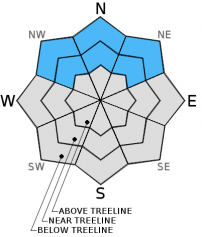| Wednesday | Wednesday Night | Thursday | |
|---|---|---|---|
| Weather: | Mostly Cloudy | Cloudy with snow becoming likely after midnight | Cloudy with snow in the morning. Snow and clouds decreasing in the afternoon |
| Temperatures: | 39 to 46 deg. F. | 14 to 21 deg. F. | 17 to 24 deg. F. |
| Mid Slope Winds: | Southwest | West | Northeast |
| Wind Speed: | 15-20 mph with gusts to 30 mph increasing to 20-30 mph with gusts to 40 mph in the afternoon | 15-20 mph with gusts to 35 mph | 15-20 mph with gusts to 30 mph increasing to 20-30 mph with gusts to 40 mph in the afternoon |
| Expected snowfall: | 0 | up to 1 | 2-5 |
| Wednesday | Wednesday Night | Thursday | |
|---|---|---|---|
| Weather: | Mostly Cloudy | Cloudy with snow becoming likely after midnight | Cloudy with snow in the morning. Snow and clouds decreasing in the afternoon |
| Temperatures: | 40 to 46 deg. F. | 15 to 21 deg. F. | 17 to 23 deg. F. |
| Ridge Top Winds: | Southwest | Southwest shifting to the West after midnight | Northeast |
| Wind Speed: | 30-40 mph with gusts to 50 mph increasing to gusts to 60 mph in the afternoon | 35-40 mph with gusts to 60 mph decreasing to 25-30 mph with gusts to 40 mph after midnight | 25-30 mph with gusts to 45 mph increasing to 30-40 mph with gusts to 60 mph in the afternoon |
| Expected snowfall: | 0 | up to 1 | 2-5 |

























